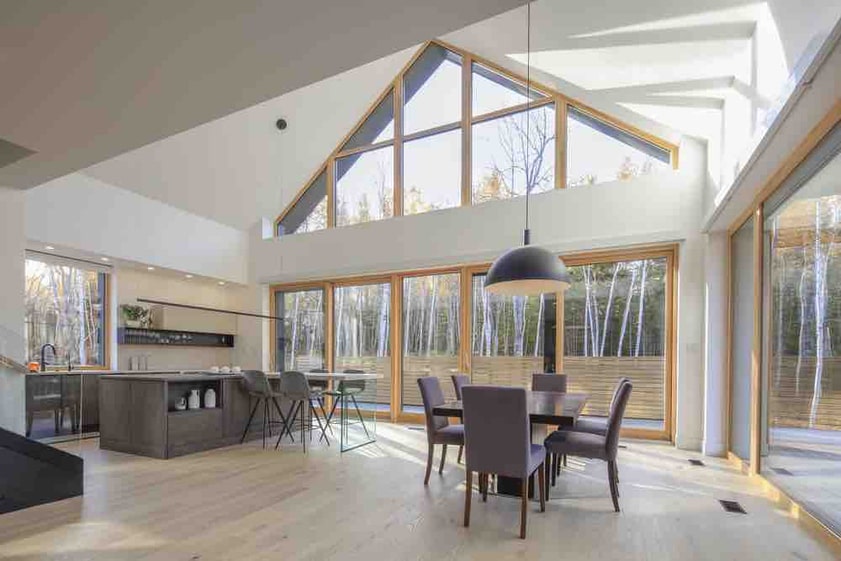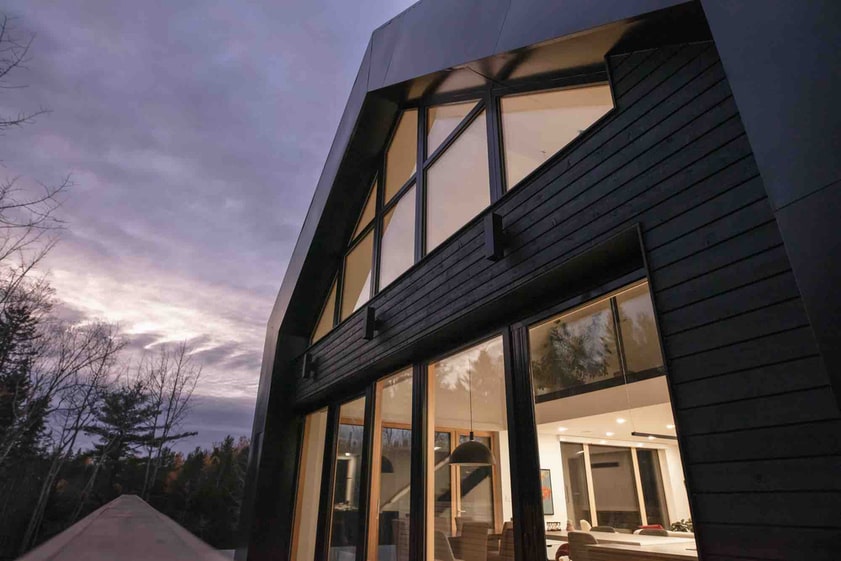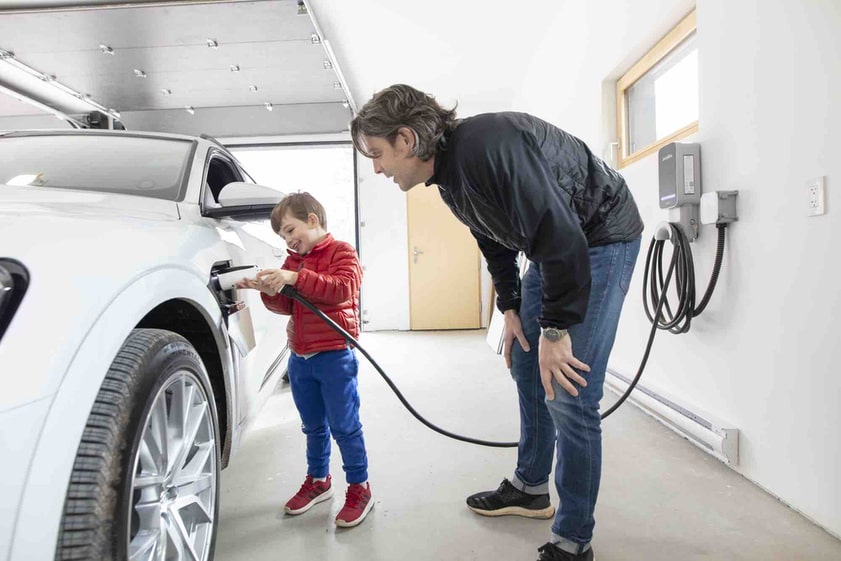Rise of the smart home: A look at the Scoudouc River Passive House

As awareness increases around climate change, more families and individuals are seeking a greener lifestyle. Do you want to reduce your carbon footprint? If so, two key areas to explore in reducing carbon emissions are your transportation habits and your home. That’s because together, transportation and housing account for more than half of an individual’s carbon footprint within the U.S.
The easiest ways to reduce your carbon emissions associated with transportation are to fly less (that’s easy these days!) and drive electric. On the energy savings side, you can go green without building a new house. There are numerous energy efficiency and smart home energy performance upgrades you can make to your existing house to have a positive impact on the environment and help in efforts to reduce climate change. The affordability and complexity of these approaches may vary, but there are many simple, quick, and affordable ways to turn your home into an energy efficient smart home.
This passive house design in New Brunswick, Canada is a smart, eco-friendly dream home you can take inspiration from. This article will explain key sustainable design concepts, such as the passive homes and smart homes, and highlight sustainable passive house design elements of the Scoudouc River Passive House.
What is a passive house?
A passive home leverages passive building principles to attain a high level of energy performance and building comfort. The concept of passive building dates back to antiquity. Ancient civilizations took advantage of thermal elements, such as the direction and angle of the sun, or materials used within a building, to provide natural heating and cooling without the use of electricity. Of course this was an essential need since electricity did not exist! Over the last two decades, as more people have become interested in improving home energy efficiency and their ecological footprint, the idea of passive housing has returned with renewed popularity and is widely practiced today.
In this type of structure, the passive movement of air within a home is optimized to maintain thermal comfort with minimal space conditioning or heating required. A common example of passive design principle is a solarium designed to face south towards the equator, to provide natural passive heating. Low-energy heating can also be accomplished with high insulation, high performance windows, and air-tight enclosures to prevent heat transfer. Passive house principles can be applied to all building types, from single-family homes, to multi-family apartments, to office buildings and even skyscrapers.
What is a smart home?
Savvy homeowners are upgrading their existing home appliances with smart, WiFi connected devices to take charge of their energy savings. In smart homes, green technology is often a core design principle where nearly every element of the home, such as the thermostat, refrigerator, lighting, blinds, and EV charger, are all digitally connected. Smart devices allow homeowners to monitor and control their energy consumption. They also typically provide scheduling and automation features to make users’ lives easier while improving energy efficiency.
More and more, homeowners and tenants expect to have the convenience of managing their everyday appliances through their phones. Whether it’s home energy consumption, security, or health, people today appreciate the benefits of ease, control, sustainability and access to useful data.
This trend of utilizing technology to improve home life has been progressing for decades with the growth of the Internet-of-Things. Once inspired by early adopters and tech geeks, now mainstream residents seek digital connectivity and want to be able to say, “Hey Google, turn off the lights.”
The green dream: Off-grid solar + storage + EV charging

The dream of a green home continues to increase. A recent National Realtors’ Association survey found that nearly 70% of homebuyers prefer sustainable, efficient homes. The Scoudouc River Passive House in Shediac, New Brunswick, Canada, is a dream green home. It was designed by Lise Fournier - Filo plus, built by Riko Homes, and engineered by HAVEN. The 2,600 square foot home (with a 1,300 square foot mezzanine!) was completed for the LeBlanc family in under 10 months.
The family and the team of designers and builders are passionate about green building. “We really pushed for the most energy efficient envelope, which was principle to our design,” said Richard LeBlanc. “The building is as energy efficient as possible, which makes a lot of sense and the payback period is relatively short.”
The certified passive house has been outfitted with passive solar design and passive heating. The home is a 100% off-grid passive house that gets its energy from an array of 20 kW solar panels, 100 kW lithium-ion battery system, and a geothermal heat pump. Despite harsh Canadian weather conditions, the house stays warm and comfortable year-round due to its passive design that controls ventilation and heat loss. The energy used comes from 100% off-grid clean energy sources. This is the passive house standard.
The family outfitted their garage with two Enel X JuiceBox Smart EV Chargers, each with their own 50-amp circuit and breaker, to have ready for the Tesla Cybertruck they have ordered. They are particularly excited about the scheduling feature, which allows them to schedule the timing of vehicle charging with times when there is ample energy available, such as in the middle of the day when production from solar panels often peaks. Enel X data shows that a popular hour to charge is between 11-12am , during off-peak energy hours.

Another key smart EV charging feature the family plans to take advantage of is load balancing. If more than one electric vehicle is plugged in at a time and needs to charge, load balancing enables JuiceBox customers to reduce and cap total EV charging load. With load balancing, you can control the amount of energy delivered to the vehicle so that it does not exceed a certain amount of kilowatts.
Smart home features
The home uses a wide variety of smart home appliances, listed below:
Lighting and Shades
LEDs + Lutron Controls, wifi enabled
Window Technology
Vetta Tilt and Turn European Windows
Ventilation
Alnor PremAir 450, auto relative humidity and CO2 controls
Voice Controls
Google Home + Amazon Alexa light switches
Smart Speakers
Sonos
Door Deadbolts and Garage Doors
WiFi-enabled
EV Charging
Enel X JuiceBox Home EV Chargers
TV
Harmony Software, WiFi-enabled
Camera
Dahua Technology
Doorbell
Dahua WiFi Video doorbell
Garden Controls
Exterior lights and exterior speakers
Fireplace
Renaissance Linear 50 Wood Burning Fireplace
Kitchen / Bath Water Appliances
Riobel


